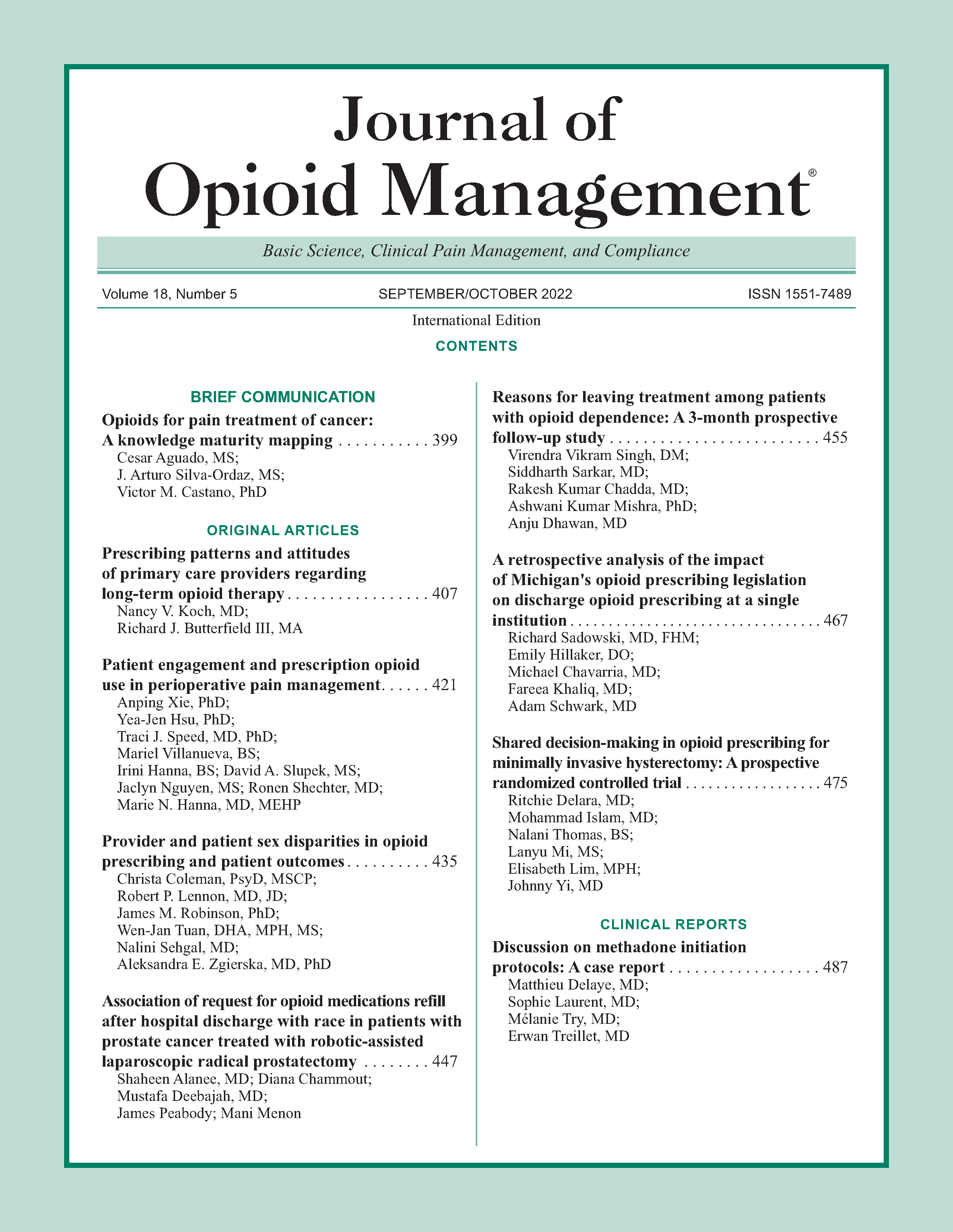A retrospective analysis of the impact of Michigan's opioid prescribing legislation on discharge opioid prescribing at a single institution
DOI:
https://doi.org/10.5055/jom.2022.0740Keywords:
opioid, legislation, prescribing, MichiganAbstract
This study sought to determine if there were any changes in opioid prescribing habits of providers at a single institution after the implementation of legislation to increase opioid prescribing regulations. Our study demonstrated a 39.5 percent decrease in overall morphine milligram equivalent (MME) prescribed the year after the laws took effect when compared with the year prior. It is clear that these laws have been effective in decreasing the number of opioids prescribed at discharge from Mercy Health Grand Rapids.
Introduction: Opioid use disorder has become an epidemic with approximately 130 people dying every day in the United States due to prescription and illegal opioid overdoses. In December 2017, the Michigan legislature ratified a package of 10 acts to address a variety of problems through several layers of regulations including more restrictive prescribing rules, which took effect in June 2018.
Objective: To evaluate the impact of legislation on the opioid prescribing habits of providers who discharged patients from a community-based academic teaching hospital.
Design, setting, and participants: A retrospective cohort study was performed using data from a community-based academic teaching hospital with 303 beds, a medical ICU, labor and delivery unit, and a 42-room emergency department. All patients discharged from in-patient or observation status in the 12 months before and after June 1, 2018 were included.
Main outcomes and measures: The primary outcome was MMEs of opioids prescribed at discharge before (June 1, 2017 to May 31, 2018) and after (June 1, 2018 to May 31, 2019) legislation. Medications included morphine, hydrocodone, oxycodone, fentanyl, methadone, hydromorphone, tramadol, codeine, and meperidine.
Results: There were 17,227 patients discharged during the first 12-month period and 15,855 patients discharged in the second 12-month period. There were 14,064 new opioid prescriptions in total during these time periods. Total MME prescribed during the study period showed a 39.5 percent decrease from pre- (2,268,460 MME) to post-legislation (1,372,424 MME), while average MMEs/discharge significantly decreased (135.1 ± 321.2 vs. 87.6 ± 187.4; p < 0.001). Total pill/patch count decreased by almost 40 percent. For patients who were prescribed opioids, average MME/discharge showed significant decline after legislation implementation (309.6 ± 427.1 vs. 212.2 ± 242.1; p < 0.001). Average daily MME/patient prescribed an opioid remained similar between the time periods (52.4 ± 37.0 vs. 51.6 ± 35.0; p = 0.21). Significant reductions (p < 0.05) were seen in MMEs for each individual medication with the exception of acetaminophen-codeine and methadone.
Conclusions and relevance: Our results indicate that the legislation implemented in Michigan to regulate opioid prescriptions was associated with a reduction in opioids prescribed to patients discharged from a community-based academic teaching hospital.
References
Centers for Disease Control and Prevention: Opioid overdose drug overdose deaths. Available at https://www.cdc.gov/drugoverdose/data/statedeaths.html. Accessed November 2, 2020.
Michigan.gov: Opioid resources: Get the facts about opioids. Avai lable at https://www.michigan.gov/opioids/0,9238,7-377-88139---,00.html. Accessed November 2, 2020.
Centers for Disease Control and Prevention: Opioid overdose drug overdose deaths rates. Available at https://www.cdc.gov/drugoverdose/data/statedeaths/drug-overdose-death-2017.html. Accessed November 2, 2020.
Calley B, Schuette B, Lyon N, et al.: Michigan prescription drug and opioid task force report of findings and recommendations for action. 2015. Available at https://www.michigan.gov/documents/snyder/Presciption_Drug_and_Opioid_Task_Force_Report_504140_7.pdf. Accessed November 2, 2020.
Department of Licensing and Regulatory Affairs (LARA) and the Michigan Department of Health and Human Services: Michigan opioid laws: Frequently asked questions (FAQs). 2019. Available at https://www.michigan.gov/documents/lara/LARA_DHHS_Opioid_Laws_FAQ_05-02-2018_622175_7.pdf. Accessed November 2, 2020.
CMS.gov: Opioid morphine equivalent conversion factors. 2015. Available at https://www.cms.gov/medicare/prescriptiondrug-coverage/prescriptiondrugcovcontra/downloads/opioidmorphine-eq-conversion-factors-march-2015.pdf. Accessed November 2, 2020.
Michigan.gov, Department of Licensing and Regulatory Affairs: Annual drug utilization reports. Available at https://www.michigan.gov/lara/0,4601,7-154-89334_72600_72603_55478_55479---,00.html. Accessed November 2, 2020.
NIDA: Michigan: Opioid-involved deaths and related harms. National Institute on Drug Abuse Website. 2020. Available at https://www.drugabuse.gov/drug-topics/opioids/opioid-summaries-by-state/michigan-opioid-involved-deaths-related-harms. Accessed November 17, 2020.
Vu JV, Howard RA, Gunaseelan V, et al.: Statewide implementation of postoperative opioid prescribing guidelines. N Engl J Med. 2019; 381(7): 680-682.
Florence CS, Zhou C, Luo F, et al.: The economic burden of prescription opioid overdose, abuse, and dependence in the United States, 2013. Med Care. 2016; 54(10): 901-906.
Shah A, Hayes CJ, Martin BC: Characteristics of initial prescription episodes and likelihood of long-term opioid use—United States, 2006–2015. MMWR Morb Mortal Wkly Rep. 2017; 66(10): 265-269.
Published
How to Cite
Issue
Section
License
Copyright 2005-2025, Weston Medical Publishing, LLC and Journal of Opioid Management. All Rights Reserved.











